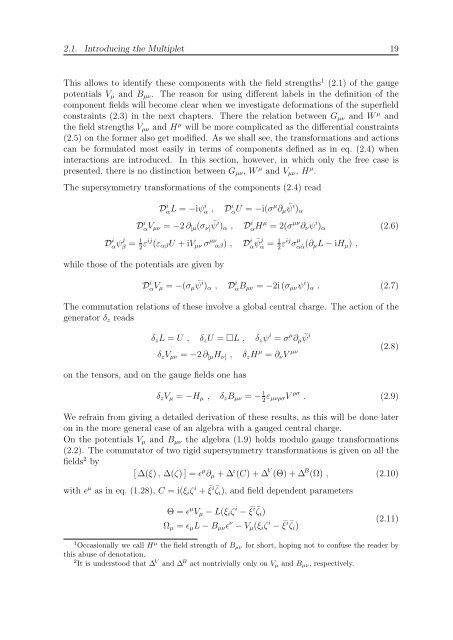N=2 Supersymmetric Gauge Theories with Nonpolynomial Interactions
N=2 Supersymmetric Gauge Theories with Nonpolynomial Interactions
N=2 Supersymmetric Gauge Theories with Nonpolynomial Interactions
Create successful ePaper yourself
Turn your PDF publications into a flip-book with our unique Google optimized e-Paper software.
2.1. Introducing the Multiplet 19<br />
This allows to identify these components <strong>with</strong> the field strengths 1 (2.1) of the gauge<br />
potentials Vµ and Bµν. The reason for using different labels in the definition of the<br />
component fields will become clear when we investigate deformations of the superfield<br />
constraints (2.3) in the next chapters. There the relation between Gµν and W µ and<br />
the field strengths Vµν and H µ will be more complicated as the differential constraints<br />
(2.5) on the former also get modified. As we shall see, the transformations and actions<br />
can be formulated most easily in terms of components defined as in eq. (2.4) when<br />
interactions are introduced. In this section, however, in which only the free case is<br />
presented, there is no distinction between Gµν, W µ and Vµν, H µ .<br />
The supersymmetry transformations of the components (2.4) read<br />
D i αL = −iψ i α , D i αU = −i(σ µ ∂µ ¯ ψ i )α<br />
D i αVµν = −2 ∂[µ(σν] ¯ ψ i )α , D i αH µ = 2(σ µν ∂νψ i )α (2.6)<br />
D i αψ j 1<br />
β = 2εij (εαβU + iVµν σ µν αβ) , D i α ¯ ψ j 1<br />
˙α = 2εijσ µ<br />
α ˙α (∂µL − iHµ) ,<br />
while those of the potentials are given by<br />
D i αVµ = −(σµ ¯ ψ i )α , D i αBµν = −2i (σµνψ i )α . (2.7)<br />
The commutation relations of these involve a global central charge. The action of the<br />
generator δz reads<br />
δzL = U , δzU = L , δzψ i = σ µ ∂µ ¯ ψ i<br />
δzVµν = −2 ∂[µHν] , δzH µ = ∂νV µν<br />
on the tensors, and on the gauge fields one has<br />
(2.8)<br />
δzVµ = −Hµ , δzBµν = − 1<br />
2 εµνρσV ρσ . (2.9)<br />
We refrain from giving a detailed derivation of these results, as this will be done later<br />
on in the more general case of an algebra <strong>with</strong> a gauged central charge.<br />
On the potentials Vµ and Bµν the algebra (1.9) holds modulo gauge transformations<br />
(2.2). The commutator of two rigid supersymmetry transformations is given on all the<br />
fields 2 by<br />
[ ∆(ξ) , ∆(ζ) ] = ɛ µ ∂µ + ∆ z (C) + ∆ V (Θ) + ∆ B (Ω) , (2.10)<br />
<strong>with</strong> ɛ µ as in eq. (1.28), C = i(ξiζ i + ¯ ξ i ¯ ζi), and field dependent parameters<br />
Θ = ɛ µ Vµ − L(ξiζ i − ¯ ξ i ¯ ζi)<br />
Ωµ = ɛµL − Bµνɛ ν − Vµ(ξiζ i − ¯ ξ i ¯ ζi)<br />
(2.11)<br />
1 µ Occasionally we call H the field strength of Bµν for short, hoping not to confuse the reader by<br />
this abuse of denotation.<br />
2 V B It is understood that ∆ and ∆ act nontrivially only on Vµ and Bµν, respectively.

















